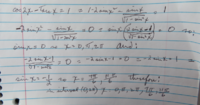allegansveritatem
Full Member
- Joined
- Jan 10, 2018
- Messages
- 962
Here is the problem:
Here is what I tried to do..it is pretty gibberishy because I seem to start here in medias res, but actually this is just one part of my endeavors and it is presented here merely to give some idea what I tried:
The key to the problem seems to be to translate tan into some form of cos that will then allow me to transform the left side into factors that can be zeroed. No?
PS: This is not an identity but an equation and I am asked to find the solutions for the interval (0,2 pi)

Here is what I tried to do..it is pretty gibberishy because I seem to start here in medias res, but actually this is just one part of my endeavors and it is presented here merely to give some idea what I tried:

The key to the problem seems to be to translate tan into some form of cos that will then allow me to transform the left side into factors that can be zeroed. No?
PS: This is not an identity but an equation and I am asked to find the solutions for the interval (0,2 pi)
Last edited:

